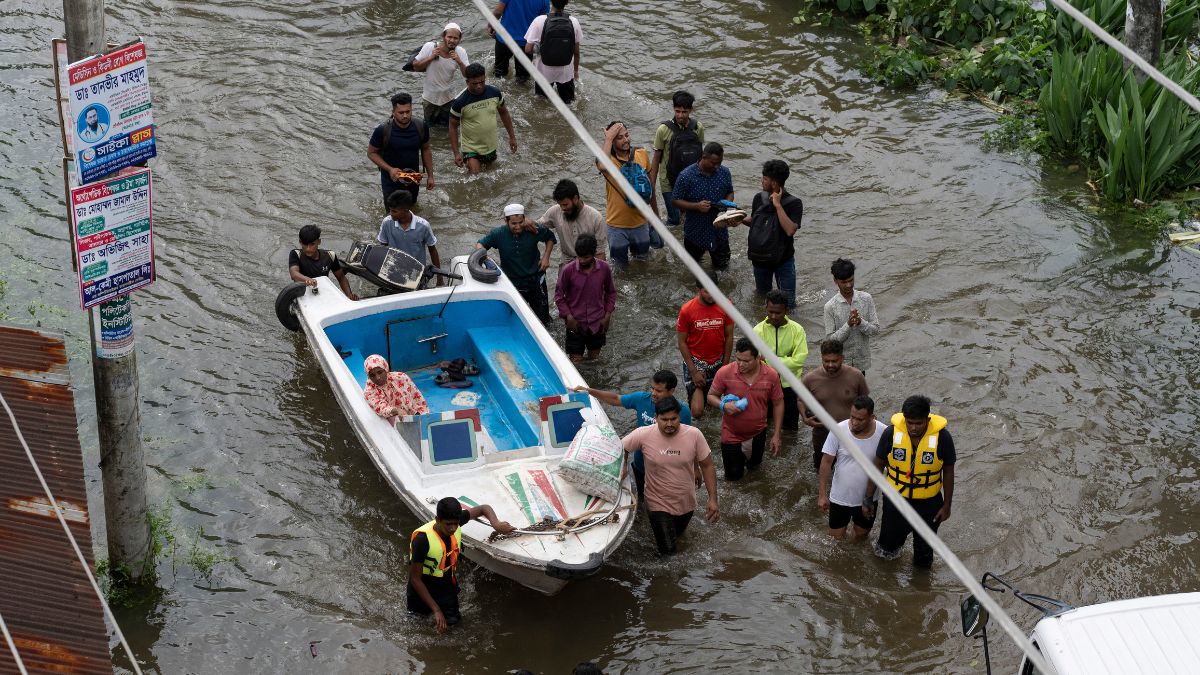Around 470,000 people have taken refuge in 3,500 shelters in the flood-hit districts, where around 650 medical teams are on the ground to provide treatment, with the army, air force, navy, and the South Asian country’s border guard assisting in rescue and relief operations read more
)
People bring a speed boat to rescue stranded residents in a flooded area of Feni, a coastal district in southeast Bangladesh, Friday, Aug. 23, 2024. Reuters
The death toll from the devastating flooding in Bangladesh, triggered by relentless monsoon rains and overflowing rivers, has reached 23 on Monday. Besides, 1.24 million families across 11 districts are stranded due to the floods.
Despite the gradual receding of floodwaters, around 5.7 million people remain isolated, with many urgently requiring food, clean water, medicine, and dry clothing. The situation is particularly dire in remote areas where blocked roads have severely hampered rescue and relief operations.
The Bangladesh Meteorological Department said that flood conditions could persist if the monsoon rains continued, as water levels were slowly receding.
In a televised address on Sunday, Government Chief Adviser Mohammad Yunus said that the administration has adopted all necessary measures to ensure a swift return to normality for flood victims.
In Bangladesh, rumors spread online that the flooding was caused by India opening the Dumbur dam in Tripura, causing several anti-India protests. India’s External Affairs Ministry denied the connection, pointing out that the dam is far from the border and that heavy rains had caused major flooding over a wide area in both countries.
However, New Delhi has rejected.“We have begun discussions with neighbouring countries to prevent future flood situations,” Yunus said. The Bangladesh Meteorological Department has warned that flood conditions could persist if the monsoon rains continue, as water levels are slowly receding.
Vast areas of land are submerged, posing a significant threat to crops if the floodwaters linger for an extended period, agriculture ministry officials said.
An analysis in 2015 by the World Bank Institute estimated that 3.5 million people in Bangladesh, one of the world’s most climate-vulnerable countries, were at risk of annual river flooding. Scientists attribute the exacerbation of such catastrophic events to climate change.
”Countries like Bangladesh with negligible emissions and whose people have shown super resilience deserve immediate funds to address the impacts of climate change and frequent disasters,” said Farah Kabir, director of ActionAid Bangladesh.
”We need to recover from the losses and damage we have faced, as well as build resilience to future impacts and take on green development pathways.”
In one of the worst-hit districts, Noakhali, 56-year-old Shukuri Begum lost her home as it was swept into a pond by the floodwaters, according to ActionAid. Terrified, she fled with her grandchildren to a neighbour’s house, but couldn’t stay there long as it was no longer safe.
”I have a son with physical disabilities, and we couldn’t bring him with us. We had to stack beds and leave him on top, hoping he would be safe. I don’t know what’s waiting for us,” ActionAid quoted her as saying.
With inputs from agencies.

 3 weeks ago
4
3 weeks ago
4
)
)
)
)
)
)
)
)
)
)
)
)
)
)
)
)
)
)
)
)
)
)
)
)
)
 English (US) ·
English (US) ·